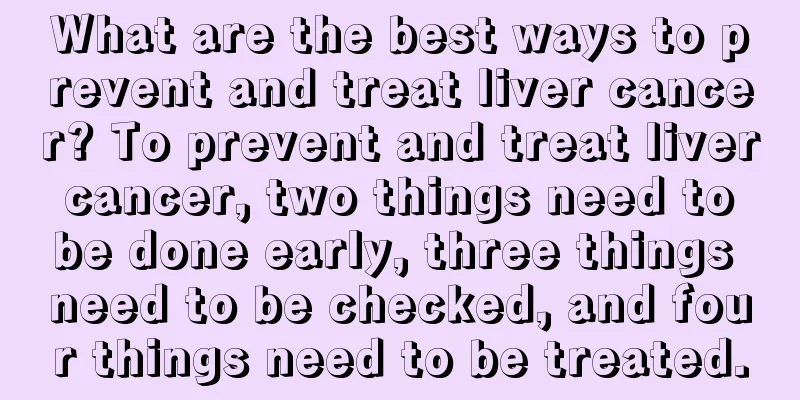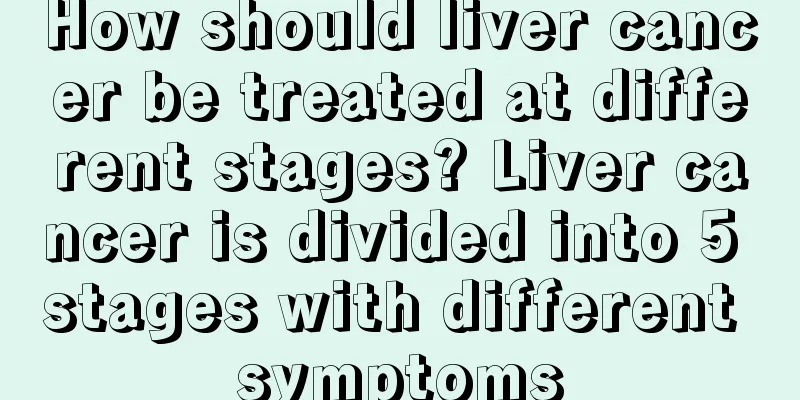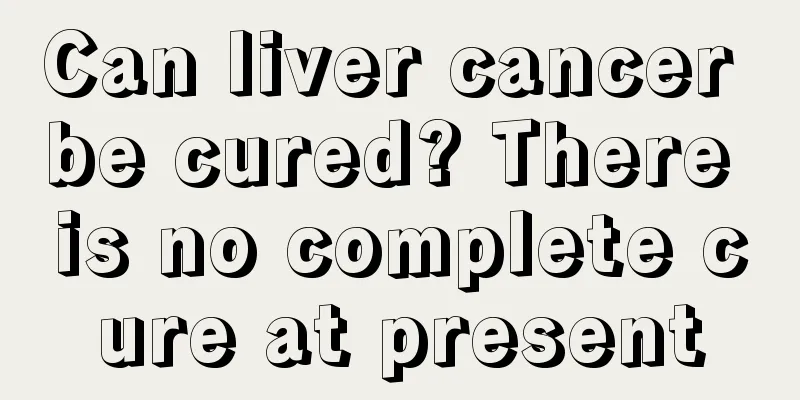What are the best ways to prevent and treat liver cancer? To prevent and treat liver cancer, two things need to be done early, three things need to be checked, and four things need to be treated.

|
Clinical practice has shown that the treatment effects of small liver cancer with a diameter of less than 3 cm and advanced liver cancer are completely different. Advanced liver cancer is often accompanied by intrahepatic and extrahepatic metastasis, which cannot be surgically removed, and interventional embolization and drug treatment are difficult to be effective. However, for small liver cancer diagnosed early, surgical resection, embolization, ablation and other treatment methods are all good. Early prevention is to avoid the spread of hepatitis, avoid liver damage caused by alcohol, drugs, etc., and prevent or alleviate the progression of liver fibrosis to the greatest extent. "Three checks": three-level census management, that is, conducting different checks according to three groups of people. According to the degree of liver cancer risk, people at high risk of liver cancer are generally divided into three categories. The first category is the high-risk group, such as patients who develop cirrhosis due to chronic viral hepatitis (hepatitis B or hepatitis C); the second category is the moderate-risk group, such as patients with chronic viral hepatitis but no family history of cirrhosis or liver cancer; the third category is the low-risk group, such as patients with cirrhosis due to non-viral reasons. The three-level census is to conduct different examinations according to the three groups of people. Generally, the high-risk group should undergo relevant examinations (liver function, alpha-fetoprotein and ultrasound) every three months; the moderate-risk group should undergo examinations at least once every six months; and the low-risk group should undergo relevant examinations once a year. When a suspicious case is found, CT, MRI or arterial angiography should be further performed until liver cancer is ruled out. “Four treatments”: the four commonly used treatment measures for liver cancer. Surgical treatment is traumatic and expensive. In addition, liver lobectomy is affected by factors such as liver function, liver cancer location, and medical technology conditions. It is not an ideal choice for patients with cirrhosis. Local treatment, represented by radiofrequency, is less invasive, causes less damage to the liver, and can be used repeatedly. It has become the preferred treatment method for small liver cancer. The efficacy of interventional embolization therapy is restricted by the blood supply to the tumor artery, making it difficult to completely kill liver cancer cells, and it has no obvious therapeutic effect on the lesions in the liver tissue surrounding the cancer. Drug treatment includes chemotherapy, immunotherapy, traditional Chinese medicine, gene therapy, etc. Drug treatment is only an auxiliary to surgical treatment, and its efficacy is limited when used alone. |
<<: What are the treatments for liver cancer? The three most effective treatments for liver cancer
Recommend
What are the diagnostic tools for osteosarcoma
Now more and more children or teenagers are unfor...
How is lung cancer caused? The four high-risk factors are most likely to induce lung cancer
What are the causes of lung cancer? In recent yea...
How to make mango pancake skin
Mango is a relatively good fruit and has excellen...
When you open your mouth, your cheek bones will make noises
In daily life, many people will hear a clicking s...
What causes rotavirus
Rotavirus is a common virus. When a person is inf...
Which hospital is good for stage III lymphoma
Almost all lymphoma patients present with painles...
Can vitamin C be taken on an empty stomach?
Vitamin C generally should not be taken on an emp...
Vaginal contact bleeding should alert you to cervical cancer
Wang Ying is 43 years old today. One year ago, sh...
Traumatic subarachnoid hemorrhage should be treated promptly
Subarachnoid hemorrhage has primary causes and se...
Will a 4-year-old baby get laryngeal cancer?
Laryngeal cancer is more common in the elderly, s...
What to do if a fracture patient has constipation
Fracture is a common disease in life. The treatme...
What are the rhomboid muscle training methods
In today's life, many people have paid extrem...
What are the symptoms of lacrimal gland inflammation
Many people do not know enough about lacrimal gla...
Calories of grilled cold noodles
I think everyone should be familiar with pasta, r...
What should I do if clothes become longer the more I wash them?
Washing clothes is a necessary activity in life b...









